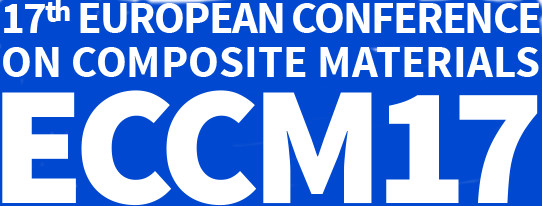

App-Einstellungen:
ACOUSTIC EMISSION FEATURES IN TEXTILE REINFORCED THERMOSET AND THERMOPLASTIC COMPOSITES
Alessandro D’Ettorre (Politecnico di Milano) Valter Carvelli (Politecnico di Milano) Stepan Lomov (KU Leuven)
The Acoustic Emission cluster analysis was applied to investigate the AE clustering in thermoset and thermoplastic reinforced 2D textiles. The initial cracks observation showed the correlation to the cluster of low amplitude and low frequency events.
ARCHITECTURAL DESIGN OF 3D WOVEN COMPOSITES ASSISTED BY FE MULTISCALE MODELING
Quentin Roirand (MINES ParisTech) Alain Thionnet (MINES ParisTech) Lucien Laiarinandrasana (MINES ParisTech)
Composite materials reinforced with three-dimensional polymeric yarns fabric are investigated. This study aims at providing some rules for an architecture optimization of woven composites in regard with the failure processes.
AVOIDING INTERPENETRATIONS AND FIBRE VOLUME FRACTION CORRECTIONS IN REPRESENTATIVE UNIT CELLS FOR TEXTILE COMPOSITES THROUGH ADVANCED GEOMETRY GENERATION
Ruben Sevenois (Ghent University) David Garoz Gomez (Ghent University) Francisco A. Gilabert (Ghent University) Wim Van Paepegem (Ghent University)
A new geometry generation method for RUCs is shown which takes into account ply nesting and generates yarn cross sectional areas as observed from in-situ measurements. The generated geometry can be used for local stress and strain field prediction.
AVOIDING SPURIOUS TRANSVERSE MODES IN 3D TEXTILE COMPOSITE REINFORCEMENT FORMING SIMULATION
Philippe Boisse (INSA de Lyon) S. Mathieu (INSA de Lyon) N. Hamila (INSA de Lyon)
The specific anisotropy of 3D reinforcements due to the possible slippage between fibers induces spurious transverse modes in bending-dominated 3D simulations. 2 solutions are proposed. One uses an assumed strain method. The second bending stiffness.
CHARACTERISTIC LOAD CASES OF BIAXIAL BRAIDS
Daniel Michaelis (University of Stuttgart) Peter Middendorf (University of Stuttgart)
CFRP specimens are tested in tension and compression, and two characteristic load cases are identified by examining the damage behaviour: in load case 1 failure is triggered by shear, while in load case 2 failure is dominated by cross-fibre tension.
COUPLED STRESS AND ENERGY ANALYSIS OF CRACK ONSET IN TEXTILE COMPOSITES AT THE MESOSCOPIC SCALE
Martin Hirsekorn (ONERA-The French aerospace Lab) Aurélien Doitrand (ONERA-The French aerospace Lab) Christian Fagiano (ONERA-The French aerospace Lab) Vincent Chiaruttini (ONERA-The French aerospace Lab)
The energy condition allows for an estimation of the initiation location and length of transverse yarn cracks, and the subsequent yarn-yarn decohesion. The use of a stress criterion alone significantly underestimates the strain at damage onset.
DAMAGE MECHANISM IN OPEN HOLE CARBON TEXTILE REINFORCED EPOXY COMPOSITES
Valter Carvelli (Politecnico di Milano) Kazuya Okubo (Doshisha University) Toru Fujii (Doshisha University)
In this experimental investigation the damage mechanisms and the damage evolution were observed during tensile quasi-static and cyclic loadings of open hole carbon balanced plain weave reinforced epoxy laminates.
ENVIRONMENTAL EFFECTS ON HIGH TEMPERATURE FATIGUE OF CARBON-POLYIMIDE TEXTILE COMPOSITES FOR AIRCRAFT APPLICATIONS
Federico Foti (ENSMA) Marco Gigliotti (ENSMA) Yannick Pannier (ENSMA) D. Mellier (ENSMA)
Fatigue test on carbon fiber/ polyimide matrix composite samples are performed under controlled environment at 250°C. Digital Image Correlation and µCT scans are used, respectively, to measure strain at the sample surface and for damage assessment.
NUMERICAL INVESTIGATION OF BRAIDED BASALT FIBER BRAIDS FOR POLYMER COMPOSITES
Yordan Kyosev (Hochschule Niederrhein) Alena Cordes (Hochschule Niederrhein)
This paper presents analysis of the possibilities of WiseTex and TexMind Braider for generation of the geometry of flat braids, produced of basalt fibers rowings.
EXPERIMENTAL CHARACTERIZATION OF TRIAXIAL BRAIDED COMPOSITES
Alejandro García-Carpintero (IMDEA Materials Institute) J.W. Roelse (Eindhoven University of Technology) J. J. M. Knippenberg (Eindhoven University of Technology) Jian Xu (IMDEA Materials) Claudio Lopes (IMDEA Materials Institute) Carlos González (Polytechnic University of Madrid & IMDEA Materials Institute)
An in-plane mechanical characterization and fracture toughness tests were carried out on triaxially braided composites at coupon level. In addition, the present damage mechanisms were identified .
